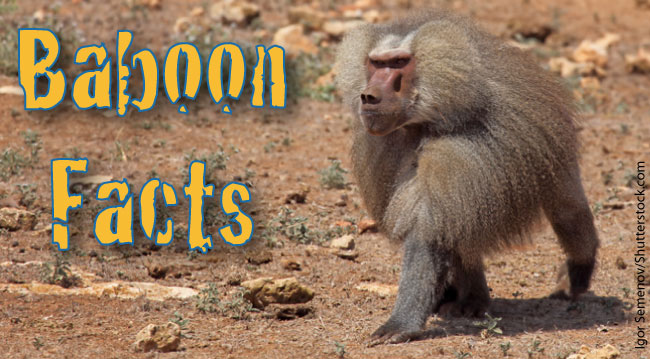Baboons are monkeys that live in Africa and Arabia. Most baboons are social animals that live in groups called ‘troops’. This page contains baboon facts, and is part of our African Animals series.
Baboon Facts
Baboons are monkeys of genus Papio. Six species of baboon are currently recognized. They are listed below, together with their scientific names and the conservation status of each.
- Hamadryas baboon Papio hamadryas Least Concern
- Guinea baboon Papio papio Near Threatened
- Olive baboon Papio anubis Least Concern
- Yellow baboon Papio cynocephalus Least Concern
- Chacma baboon Papio ursinus Least Concern
- Kinda baboon Papio kindae Least Concern
Baboon Troops
Most baboons live in groups. As with all primate species, a group of baboons is known as a “troop”. A baboon troop can contain as few as 5 or as many as 250 individuals, with the average being around 50 individuals.
Troop size depends on factors such as the species, time of year and food availability.
Social organization in baboon troops is highly complex. Males use displays of physical strength to dominate rivals. Troop members spend many hours intensely grooming each other to remove insects and dead skin. Grooming also helps to maintain social bonds between individuals.
In the video below, you can see how chacma baboons operate as a troop to see off a cheetah from their territory.
Where Do Baboons Live?
Baboons are terrestrial (ground dwelling) and are found in various habitats such as open savannah, hills and open woodland. The Guinea baboon lives in far western Africa, the chacma baboon in southern Africa, the olive baboon in the north-central African savannah, the yellow baboon in south-central and eastern Africa, and the hamadryas baboon in the Horn of Africa and south-western Arabia.
Appearance
Baboons range in size and weight depending on the species. The smallest is the Guinea baboon which is 20 in (50 cm) and weighs only 30 lb (14 kg) whereas the largest chacma baboon can be 47 in (120 cm) and weigh 90 lb (40 kg). Some of them are a grayish color whereas others are black or brownish. Some have a white mane. All baboons have a large head with a thick eye-brow ridge, long dog-like muzzle with powerful jaws and sharp canine teeth. Their eyes are close-set and on the front of their faces, giving them excellent vision. They have thick fur, except on their muzzles and their buttocks.
Baboons are well known for having protruding buttocks with rough, sometimes colored areas, called ischial callosities. These are nerveless pads of skin that enable the baboon to sit comfortably for long periods of time when they are watching for predators. Like other Old World monkeys, their tail is not prehensile (it cannot grip), however, they do climb trees. In all baboon species there are differences between the males and the females. Usually this is a difference in size, but sometimes it may be color or canine teeth differences.
Baboon Facts: Diet and Feeding
Baboons are omnivorous; although they mostly eat plants, meat does form part of their diet. The meat they eat includes insects and, when available, fish (trout and salmon), hares, birds, small antelopes, vervet monkeys and shellfish. They forage both during the day and night. It has been known for baboons to raid human dwellings, and in some cases, they have been known to prey on livestock (sheep and goats) and to eat large amounts of crops.
Reproduction
Female baboons initiate mating by presenting their swollen rump to the male, often directly into his face. After a successful mating, females are typically pregnant for about 6 months. They usually give birth to a single infant which weighs approximately 14 oz (400 g) and has black skin when born. The females tend to take care of the young rather than the males, although in some species, several females collaborate and care for all of their offspring. The young are weaned after about 1 year and reach sexual maturity in 5 to 8 years. Baboon males always leave their birth group, whereas females stay in the same group their whole lives. Baboons in captivity can live up to 45 years, although in the wild, their life expectancy is about 30 years.
Are Baboons Endangered?
Baboons are not endangered but they are threatened by habitat-loss due to agricultural expansion, overgrazing, large irrigation projects and overall human settlements.
Quick Baboon Facts For Kids
- A group of baboons is called a "troop".
- Baboons can use 10 to 30 different and unique vocalizations.
- Baboons also use non-vocal forms of communication including lip smacking and shoulder shrugging.
- Baboons share 91% of their DNA with humans.
- Male baboons tend to be at least 10 lb heavier than females.
- Male baboons can have a nose 7 times larger than females.
- Baboons are heavily hunted because of their looks - the culture in the regions they live considers them as being evil.
- If baboons see a threat, they make loud barks. The males run to attack, while the females and young run up into the trees to seek safety.
- Ancient Egyptians considered hamadryas baboons to be sacred - they related them with Thoth, the God of letters.
- The only predators of baboons, other than humans, are large cats such as leopards.
Baboon Facts Conclusion
We hope that you have enjoyed reading about baboons. You can find out about more amazing African animals here.





